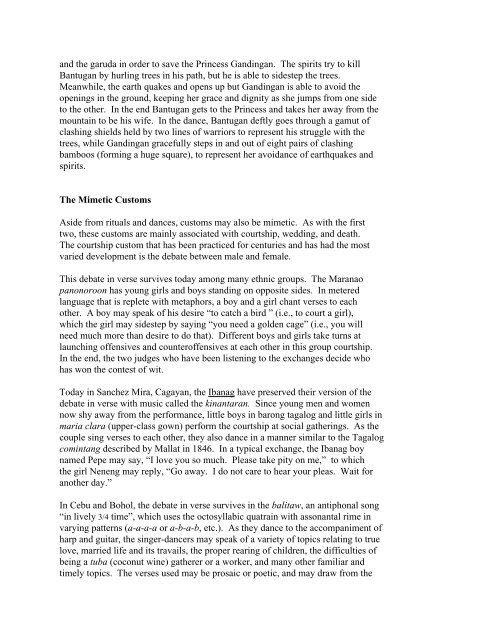THE ETHNIC TRADITION IN PHILIPPINE THEATER In the ...
THE ETHNIC TRADITION IN PHILIPPINE THEATER In the ...
THE ETHNIC TRADITION IN PHILIPPINE THEATER In the ...
Create successful ePaper yourself
Turn your PDF publications into a flip-book with our unique Google optimized e-Paper software.
and <strong>the</strong> garuda in order to save <strong>the</strong> Princess Gandingan. The spirits try to kill<br />
Bantugan by hurling trees in his path, but he is able to sidestep <strong>the</strong> trees.<br />
Meanwhile, <strong>the</strong> earth quakes and opens up but Gandingan is able to avoid <strong>the</strong><br />
openings in <strong>the</strong> ground, keeping her grace and dignity as she jumps from one side<br />
to <strong>the</strong> o<strong>the</strong>r. <strong>In</strong> <strong>the</strong> end Bantugan gets to <strong>the</strong> Princess and takes her away from <strong>the</strong><br />
mountain to be his wife. <strong>In</strong> <strong>the</strong> dance, Bantugan deftly goes through a gamut of<br />
clashing shields held by two lines of warriors to represent his struggle with <strong>the</strong><br />
trees, while Gandingan gracefully steps in and out of eight pairs of clashing<br />
bamboos (forming a huge square), to represent her avoidance of earthquakes and<br />
spirits.<br />
The Mimetic Customs<br />
Aside from rituals and dances, customs may also be mimetic. As with <strong>the</strong> first<br />
two, <strong>the</strong>se customs are mainly associated with courtship, wedding, and death.<br />
The courtship custom that has been practiced for centuries and has had <strong>the</strong> most<br />
varied development is <strong>the</strong> debate between male and female.<br />
This debate in verse survives today among many ethnic groups. The Maranao<br />
panonoroon has young girls and boys standing on opposite sides. <strong>In</strong> metered<br />
language that is replete with metaphors, a boy and a girl chant verses to each<br />
o<strong>the</strong>r. A boy may speak of his desire “to catch a bird ” (i.e., to court a girl),<br />
which <strong>the</strong> girl may sidestep by saying “you need a golden cage” (i.e., you will<br />
need much more than desire to do that). Different boys and girls take turns at<br />
launching offensives and counteroffensives at each o<strong>the</strong>r in this group courtship.<br />
<strong>In</strong> <strong>the</strong> end, <strong>the</strong> two judges who have been listening to <strong>the</strong> exchanges decide who<br />
has won <strong>the</strong> contest of wit.<br />
Today in Sanchez Mira, Cagayan, <strong>the</strong> Ibanag have preserved <strong>the</strong>ir version of <strong>the</strong><br />
debate in verse with music called <strong>the</strong> kinantaran. Since young men and women<br />
now shy away from <strong>the</strong> performance, little boys in barong tagalog and little girls in<br />
maria clara (upper-class gown) perform <strong>the</strong> courtship at social ga<strong>the</strong>rings. As <strong>the</strong><br />
couple sing verses to each o<strong>the</strong>r, <strong>the</strong>y also dance in a manner similar to <strong>the</strong> Tagalog<br />
comintang described by Mallat in 1846. <strong>In</strong> a typical exchange, <strong>the</strong> Ibanag boy<br />
named Pepe may say, “I love you so much. Please take pity on me,” to which<br />
<strong>the</strong> girl Neneng may reply, “Go away. I do not care to hear your pleas. Wait for<br />
ano<strong>the</strong>r day.”<br />
<strong>In</strong> Cebu and Bohol, <strong>the</strong> debate in verse survives in <strong>the</strong> balitaw, an antiphonal song<br />
“in lively 3/4 time”, which uses <strong>the</strong> octosyllabic quatrain with assonantal rime in<br />
varying patterns (a-a-a-a or a-b-a-b, etc.). As <strong>the</strong>y dance to <strong>the</strong> accompaniment of<br />
harp and guitar, <strong>the</strong> singer-dancers may speak of a variety of topics relating to true<br />
love, married life and its travails, <strong>the</strong> proper rearing of children, <strong>the</strong> difficulties of<br />
being a tuba (coconut wine) ga<strong>the</strong>rer or a worker, and many o<strong>the</strong>r familiar and<br />
timely topics. The verses used may be prosaic or poetic, and may draw from <strong>the</strong>
















